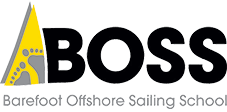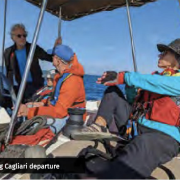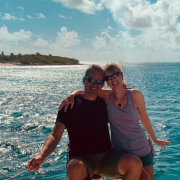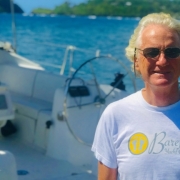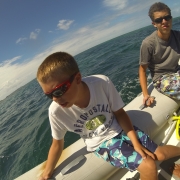Sailing from Croatia to St. Vincent, Leg 1 (October 2022)
/in Learn to Sail, Sailing School News/by Rob McleanFirst time in the Grenadines
/in Learn to Sail, News, Sailing School News/by Rob McleanFormer sailing school students, and now close friends Dave and Regina share an account of their first cruise in St. Vincent and the Grenadines.
1. Where can I find additional detailed information about Barefoot Offshore Sailing School courses?
/in Frequently Asked Questions, Learn to Sail, News, Sailing School News/by Rob McleanBarefoot Offshore Sailing School (BOSS) publishes a regularly updated BOSS Orientation Guide which addresses the following topics:
Table of Contents
- Welcome
- The Players
- St. Vincent and the Grenadines
- Overview of ASA and Sail Canada certification standards
- Preparing for your Barefoot Offshore Sailing School course
- Travelling to SVG and what happens on arrival (including Covid requirements)
- Your instructors and what you can expect from them
- What your instructors expect from you
- Typical course schedules and Itineraries
- What BOSS supplies, what you should bring, what not to bring
- Food, drinks, and provisioning
- Maximizing enjoyment of your BOSS experience
- What’s next: continuing your sailing journey
Click here for the latest version.
2. Rob’s response: As a beginning sailor starting my sailing journey, how much can I learn in a week?
/in Frequently Asked Questions, Learn to Sail, News, Sailing School News/by Rob McleanWhile many Barefoot Offshore Sailing School participants come with some sailing experience, others arrive with little or no experience as crew or helmperson on a sailboat. We welcome people with any experience level. Whatever experience and skills you arrive with, you are guaranteed to leave with more!
Many guests who sign up for our Basic or Catamaran Cruise and Learn courses ask how far they can progress? Here are some perspectives on that question.
Your sailing journey
I think of sailing knowledge and skills as a continuum or journey. As an Offshore instructor, I have the highest cruising instructor qualifications that ASA and Sail Canada offer, but I’m still on the sailing learning journey, continuing to upgrade my knowledge and skills.
If you are a novice sailor, with little or no previous experience, you are close to the beginning of that journey.
Sailing journey milestones
The first key milestone along your journey is when you have acquired the knowledge, skills and experience to be able to safely skipper a boat for a day-sail with precious cargo: family and friends on board. (This is the equivalent of Sail Canada Basic, or ASA 101 and for some, ASA 103). As skipper, you have total responsibility for the safety and well-being of everyone on board. Based on my instructing experience to date, both in Canada and here in St. Vincent, around 2/3s of people who are novice sailors can achieve SC Basic Cruising or ASA 101 in a week, and some can progress to ASA 103. However, that also means that 1/3 of novice sailors need a bit more time and experience to reach these levels.
The next key milestone along your journey is when you have acquired the knowledge, skills and experience to be able to safely skipper or charter a boat for a multi-day cruise with precious cargo: family and friends on board. (This is the equivalent of Sail Canada Intermediate, or ASA 104). As a skipper in this context, in addition to total responsibility for the safety and well-being of everyone, you have total responsibility for a yacht worth several hundred thousand dollars. Based on my instructing experience to date, lots of course participants who have previous sailing experience can get there in a week, but in all the courses I have taught, only 1 or 2 novice sailors have managed to make that much progress in a week. There is just too much to learn for most novices to achieve that in a few days.
The levels beyond that, ASA 106 or Sail Canada Advanced, require much greater knowledge, skills and experience. There is no possibility for a novice to get to those levels in a week. FYI, I progressed quickly to SC Advanced, but I already had 12,000 miles of cruising in my resume by then. You don’t need that much experience to be successful at progressing to Advanced, but you definitely need to have skippered a number of cruises and have several hundred miles of experience as skipper before it is feasible to pass an Advanced course.
As a novice sailor, where should I start?
For novice sailor, what I recommend is that you join one of our Cruise and Learn courses focusing on ASA 101-104, or Sail Canada Basic and Intermediate. (The Sail Canada option is available if the instructor on board has SC qualifications in addition to ASA qualifications.) As a novice sailor, your realistic expectation in that first week would be to be certified for ASA 101 and possibly 103, or Sail Canada Basic, and make some progress toward 104 or Sail Canada Intermediate certification on a subsequent visit. (You could also consider learning on a catamaran. Most instructors agree that there are advantages to starting out on a monohull, but we have also taught many novices to sail on a catamaran first.)
In a future visit, you can focus on completing 104 / SC Intermediate, and consider adding ASA 114 or the Sail Canada Catamaran endorsement if you are looking to become proficient at sailing a catamaran. At the end of that second week of instruction, you could potentially have built the knowledge and skills you need to charter a boat for future adventures.
Onward!
Good luck with your journey. I’m working on the next stage of my own sailing journey, and continue to take great satisfaction on helping others progress on theirs.
Rob McLean is an ASA and Sail Canada Advanced and Offshore Instructor, a Sail Canada Senior Instructor Evaluator, an ASA Master Instructor, and Barefoot Offshore Sailing School Lead Instructor and Coordinator
3. Rob’s Response: How do Sail Canada cruising courses differ from ASA?
/in Frequently Asked Questions, Learn to Sail, News, Sailing School News/by Rob McleanBarefoot Offshore Sailing School is one of the few schools in the world, and the only one in the Caribbean, that offers both ASA and Sail Canada certifications.
Participants in our courses often ask: what’s the difference between Sail Canada courses and American Sailing Association (ASA) courses? Is there an advantage to one system over the other? As a Sail Canada and ASA Advanced and Offshore Instructor, here is my perspective.
Background
Until 2018, BOSS did not offer Sail Canada courses, so all our guests were certified to ASA standards. Now, however, Sail Canada is an option for many of our offerings, and this will continue to expand in future as BOSS increases the number of instructors capable of certifying students in both systems.
Sail Canada and ASA standards are quite similar, for the principal reason that when ASA started up in the 1980s, it licensed the then Canadian Yachting Association standards as the initial basis for the ASA system. While differences have emerged in the 40 years since then, the two systems remain largely parallel.
ASA and Sail Canada Cruising Courses Overview
What are the main differences between the two systems?
The main differences between the two systems arise because Sail Canada, as the national organization for the sport of sailing in Canada, has access to a cadre of volunteers who work on regularly upgrading the standards, and the related exams and learning materials. Senior members in Sail Canada’s instructor community meet monthly to consider and implement updates to the Learn to Cruise system. (Full disclosure: I serve as a member of Sail Canada’s national Training and Certification Advisory Committee that oversees this effort. As a Sail Canada Instructor Evaluator, I contribute to the development of cruising training materials.)
As a result, the Sail Canada requirements are in general somewhat more rigourous than the ASA requirements. For instance:
• Sail Canada has split Coastal Navigation into Basic and Intermediate courses, with Basic Coastal Navigation required as a prerequisite for Intermediate Cruising
• Some content in ASA 106 Advanced is covered earlier in the SC system
• The requirements for Sail Canada Advanced Cruising and Offshore Cruising are both somewhat more extensive than the ASA requirements for the equivalent courses.
Which system should I choose?
When someone asks which system should they choose, my answer is that it depends mainly on where you expect to continue your sailing journey. If you are sailing and taking future courses mainly in the USA, ASA is the better choice. If you are sailing and taking future courses mainly in Canada, then Sail Canada is a better choice.
However, at the end of the day, what matters is that graduates of our courses are proficient, knowledgeable, and safe sailors, and emerge with credentials that are recognized world-wide. This is ultimately a result of hard work by students and their instructors, combined with a great cruising ground like the Grenadines, built on the excellent systems maintained by both organizations. BOSS is proud to accomplish this result under both systems.
Rob McLean is an ASA and Sail Canada Advanced and Offshore Instructor, a Sail Canada Senior Instructor Evaluator, and BOSS Lead Instructor and Coordinator
5. What is a Barefoot Offshore Sailing School “mentored charter”
/in Frequently Asked Questions, Learn to Sail, News, Sailing School News/by Rob McleanBarefoot Offshore Sailing School offers a “mentored charter”. This helps graduates of our sailing courses make the transition to sole responsibility as skipper of a chartered boat.
What is a mentored charter?
In a mentored charter, the charter skipper agrees to shadow one of our sailing course boats during their initial charter. The BOSS Instructor on the sailing course checks in daily with the charter skipper, and is available as needed to provide advice and feedback. There is a small incremental fee to cover the costs of mentorship.
Who is eligible for a mentored charter?
Mentored charters are available to students who have successfully completed ASA 104 or Sail Canada Intermediate. For a mentored charter on a catamaran, sudents should have also completed ASA 114 or the Sail Canada Catamaran Endorsement.
What are the benefits of a mentored charter?
Skippers who have participated in mentored charters tell us that the availability of the Instructor mentor substantially reduced the apprehension they otherwise felt at the thought of being in sole charge of a charter vessel for the first time.
On completion of a mentored charter and a recommendation from the mentoring Instructor, the charter skipper is usually eligible to book a future charter with Barefoot Yacht Charters (subject to the proficiency levels applicable to specific charter vessels).
A key benefit of a mentored charter is that it helps build a skipper’s sailing resume. This enhances your eligibility to book future charters with Barefoot or other charter operators around the world.
When can I book a mentored charter?
In many cases, guests book a mentored charter immediately after their BOSS sailing course. This helps cement the progress they made in the course. Of course, you can also book a mentored charter on your next visit to Barefoot and St. Vincent and the Grenadines.
How do I book a mentored charter?
Contact our booking team, who can explore the details with you.
6. What is a Barefoot Offshore Sailing School “private course”?
/in Frequently Asked Questions, Learn to Sail, News, Sailing School News/by Rob McleanIn addition to our normal scheduled ASA and Sail Canada courses, Barefoot Offshore Sailing School (BOSS) offers the option of a “private course”.
What is a private course?
In a private course, a guest charters and provisions a vessel from the Neptune fleet of our sister company, Barefoot Yacht Charters. There is an additional fee for a suitable BOSS instructor to be onboard for the duration of the course. This can be highly attractive to family groups or a group of close friends interested in sail instruction together.
What are the benefits of a private course?
The advantages of a private course include:
- Subject to availability, guests can select their preferred yacht from the BYC Neptune fleet
- Other than the BOSS Instructor, everyone on the boat is from the family or friend group
- Instruction can be customized based on the composition of the group, which may include more and less experienced sailors, adults and youth, etc.
- The itinerary can also be customized based on the desires of the group;
- Guests can provision the boat according to their own preferences.
How do I book a private course?
If interested in a Barefoot Offshore Sailing School private course, contact our booking team representative who can arrange for a detailed quotation for a private course.
7. Can I bring a non-participating partner on a Barefoot Offshore Sailing School course?
/in Frequently Asked Questions, Learn to Sail, News, Sailing School News/by Rob McleanBarefoot Offshore Sailing School welcomes couples to join our courses. For couples who plan to cruise together, it is important that both partners are confident sailing the boat.
I frequently invite sailing couples to consider the question: which partner is more likely to fall off the boat? Contrary to what some people think initially, the answer is, the most experienced sailor is more likely to fall overboard, because if something needs to be fixed on the boat, that person will be likely to expose him or herself to higher risks to try to fix the problem. (I’m been personally guilty of that.) So couples sailing together need to ensure that even the less-experienced sailor has sufficient skill to be able to recover the partner that has fallen overboard. You only have to put yourself mentally into that situation to realize how important this is.
We are often asked about bringing a partner along on a course. There are two situations.
The first is where one of the partners wants to participate in the instruction process, but is not interested in passing the exams or being certified. This is no problem: you can acquire the important knowledge and skills without writing the exams or being formally evaluated.
The second situation is where a student asks to bring a partner along as a guest who doesn’t plan to participate in the instruction process.
Speaking as an instructor, this is not an ideal situation, either for the couple or the other students in the course. There is a significant risk that having someone on board who isn’t participating will be a distraction for everyone. Watching students practice manoeuvres without being part of the process will inevitably be boring for the non-participant. A camaraderie always builds when a crew is working together on a boat: the non-participant will find it increasingly hard to fit in.
There can be exceptions to the general discouragement of non-participants: I led a school once where one of the participants informed me in advance that she had significant health issues that would prevent her from participating fully, but that this was an important opportunity for she and her partner to sail together. In this circumstance, everyone on the boat completely understood the situation and was fine with it.
A better option in case a student wishes to bring along non-participating friends and family is a Barefoot Offshore Sailing School “private course”: click here for details.
Rob McLean is an ASA and Sail Canada Advanced and Offshore Instructor, an ASA and Sail Canada Instructor Evaluator, and Barefoot Offshore Sailing School Lead Instructor and Coordinator
8. Can I bring my teen-aged son or daughter on a Barefoot Offshore Sailing School course?
/in Frequently Asked Questions, Learn to Sail, News, Sailing School News/by Rob McleanBarefoot Offshore Sailing School strongly encourages families to sail together. Neither ASA or Sail Canada has an age limit for certification in cruising courses.
We welcome teen participation in sailing school courses as long as:
- everyone recognizes that Barefoot Offshore Sailing School courses are designed for an adult-learning environment;
- your teen is committed to fully participate in all aspects of the instruction, progressing as far as they can along the path to certification;
- your teen is comfortable interacting with the other adult parpticipants on the course, and will not be shocked if he or she hears some non G-rated language from time to time.
Over the years, many teen sons or daughters have successfully graduated from our courses: we look forward to welcoming yours!
If you have multiple family members that you wish to include, an option to consider is a Barefoot Offshore Sailing School private course: click here for details.
BOSS on Facebook
BOSS Recent Posts
BOSS Categories
- Frequently Asked Questions (8)
- Frontpage Article (6)
- Learn to Sail (16)
- New Courses (6)
- News (18)
- Sailing School News (23)
- Uncategorized (2)
